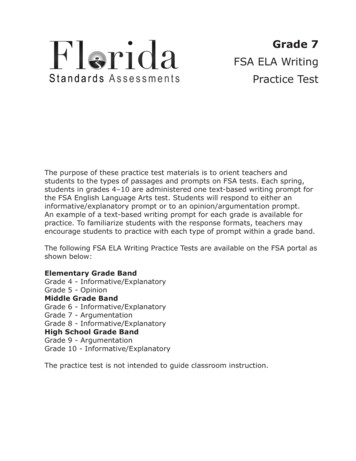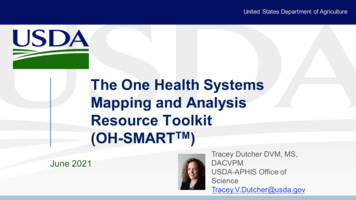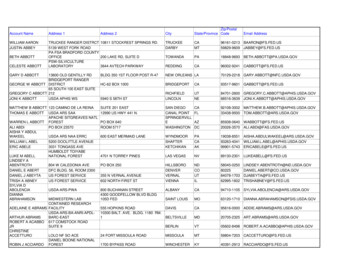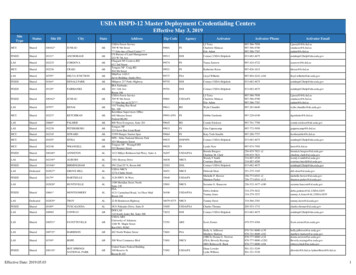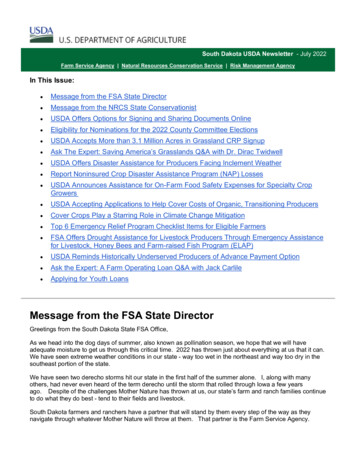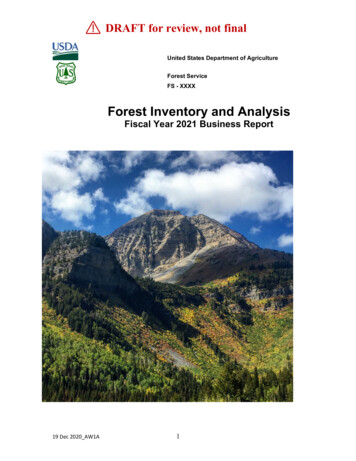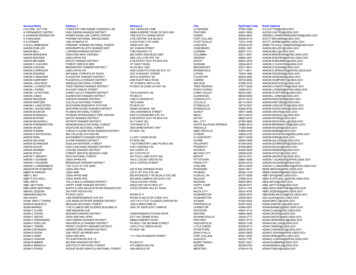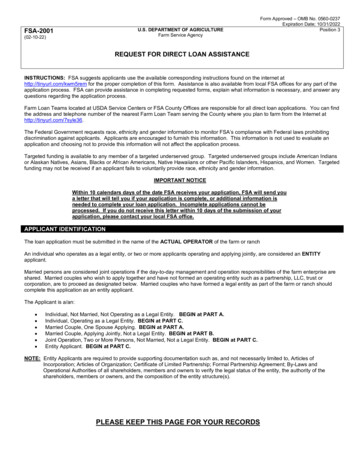
Transcription
March 2016Having trouble viewing this email? View it as a Web page. USDA Financial Assistance Available to Help Organic Farmers Create Conservation BuffersBorrower TrainingCRP Payment LimitationNew USDA Commitments to Help Build Up Next Generation of Farmers and RanchersReporting Organic CropsFiling a Notice of LossDairy Indemnity Payment ProgramSave Time – Make an Appointment with FSABreaking New GroundUpdate Your RecordsUSDA Expands Microloans to Help Farmers Purchase Farmland and Improve PropertyDisaster Set-Aside (DSA) ProgramDirect LoansGuaranteed Loan ProgramYouth LoansBeginning Farmer LoansFarmers to receive Documentation of USDA ServicesUSDA Commits 2.5 Million to Expand New Farmer EducationSelected Interest RatesPuerto Rico FSA NewsletterPuerto Rico FarmService Agency654 Muñoz Rivera Ave.654 Plaza Suite 829San Juan, PR 00918USDA Financial AssistanceAvailable to Help OrganicFarmers Create ConservationBufferswww.fsa.usda.gov/prUSDA Financial Assistance Available to HelpOrganic Farmers Create Conservation BuffersState Committee:Damián RiveraCarmen RullánUSDA is assisting organic farmers with the cost ofestablishing up to 20,000 acres of new
Luz E. BerríosActing State ExecutiveDirector:Jean P. Giuliani GiorgiExecutive Officer:Wanda J. PérezPlease contact your localFSA Office for questionsspecific to your operationor county.conservation buffers and other practices on andnear farms that produce organic crops.The financial assistance is available from theUSDA Conservation Reserve Program (CRP), afederally funded voluntary program that contractswith agricultural producers so that environmentallysensitive land is not farmed or ranched, but insteadused for conservation benefits. CRP participantsestablish long-term, resource-conserving plantspecies, such as approved grasses or trees(known as “covers”) to control soil erosion, improvewater quality and develop wildlife habitat. In return,FSA provides participants with rental paymentsand cost-share assistance. Contract duration isbetween 10 and 15 years.For conservation buffers, funds are available forestablishing shrubs and trees, or supportingpollinating species, and can be planted in blocks orstrips. Interested organic producers can offereligible land for enrollment in this initiative at anytime.Other USDA FSA programs that assist organicfarmers include: The Noninsured Crop Disaster AssistanceProgram that provides financial assistancefor 55 to 100 percent of the averagemarket price for organic crop lossesbetween 50 to 65 percent of expectedproduction due to a natural disaster.Marketing assistance loans that provideinterim financing to help producers meetcash flow needs without having to sellcrops during harvest when market pricesare low, and deficiency payments toproducers who forgo the loan in return fora payment on the eligible commodity.A variety of loans for operating expenses,ownership or guarantees with outsidelenders, including streamlined microloansthat have a lower amount of paperwork.Farm Storage Facility Loans for thatprovide low-interest financing to build orupgrade storage facilities for organiccommodities, including cold storage, grainbins, bulk tanks and drying and handlingequipment.Services such as mapping farm and fieldboundaries and reporting organic acreagethat can be provided to a farm’s organic
certifier or crop insurance agent.Visit www.fsa.usda.gov/organic to learn moreabout how FSA can help organic farmers. For aninteractive tour of CRP success stories, visitwww.fsa.usda.gov/CRPis30 or follow #CRPis30 onTwitter. To learn more about FSA programs visit alocal FSA office or www.fsa.usda.gov. To find yourlocal FSA office, visit http://offices.usda.gov.Borrower TrainingBorrower training is available for all Farm ServiceAgency customers. This training is required for alldirect loan applicants, unless the applicant has awaiver issued by the agency.Borrower training includes instruction in productionand financial management. The purpose is to helpthe applicant develop and improve skills that arenecessary to successfully operate a farm and buildequity in the operation. It aims to help theproducer become financially successful. Borrowertraining is provided, for a fee, by agency approvedvendors. Contact your local FSA Farm LoanManager for a list of approved vendors.CRP Payment LimitationPayments and benefits received under the Conservation Reserve Program (CRP) are subject to thefollowing: payment limitation by direct attributionforeign person ruleaverage adjusted gross income (AGI) limitationThe 2014 Farm Bill continued the 50,000 maximum CRP payment amount that can be receivedannually, directly or indirectly, by each person or legal entity. This payment limitation includes allannual rental payments and incentive payments (Sign-up Incentive Payments and PracticeIncentive Payments). Annual rental payments are attributed (earned) in the fiscal year in whichprogram performance occurs. Sign-up Incentive Payments (SIP) are attributed (earned) based onthe fiscal year in which the contract is approved, not the fiscal year the contract is effective.Practice Incentive Payments (PIP) are attributed (earned) based on the fiscal year in which the costshare documentation is completed and the producer or technical service provider certifiesperformance of practice completion to the county office.Such limitation on payments is controlled by direct attribution. Program payments made directly or indirectly to a person are combined with the pro rata
interest held in any legal entity that received payment, unless the payments to the legalentity have been reduced by the pro rata share of the person.Program payments made directly to a legal entity are attributed to those persons that havea direct and indirect interest in the legal entity, unless the payments to the legal entity havebeen reduced by the pro rata share of the person.Payment attribution to a legal entity is tracked through four levels of ownership. If any partof the ownership interest at the fourth level is owned by another legal entity, a reduction inpayment will be applied to the payment entity in the amount that represents the indirectinterest of the fourth level entity in the payment entity.Essentially, all payments will be “attributed” to a person’s Social Security Number. Given thecurrent CRP annual rental rates in many areas, it is important producers are aware of how CRPoffered acreages impact their 50,000 annual payment limitation. Producers should contact theirlocal FSA office for additional information.NOTE: The information in the above article only applies to contracts subject to 4-PL and 5-PLregulations. It does not apply to contacts subject to 1-PL regulations.New USDA Commitments to Help Build Up Next Generation ofFarmers and RanchersThe U.S. Department of Agriculture today announced a commitment by the U.S. Department ofAgriculture (USDA) to prioritize 5.6 billion over the next two years within USDA programs andservices that serve new and beginning farmers and ranchers. Deputy Secretary Harden alsoannounced a new, tailored web tool designed to connect burgeoning farm entrepreneurs withprograms and resources available to help them get started.The new web tool is available at www.usda.gov/newfarmers. The site was designed based onfeedback from new and beginning farmers and ranchers around the country, who cited unfamiliaritywith programs and resources as a challenge to starting and expanding their operations. The sitefeatures advice and guidance on everything a new farm business owner needs to know, from writinga business plan, to obtaining a loan to grow their business, to filing taxes as a new small businessowner. By answering a series of questions about their operation, farmers can use the site’sDiscovery Tool to build a personalized set of recommendations of USDA programs and servicesthat may meet their needs.Using the new web tool and other outreach activities, and operating within its existing resources,USDA has set a new goal of increasing beginning farmer and rancher participation by an additional6.6 percent across key USDA programs, which were established or strengthened by the 2014 FarmBill, for a total investment value of approximately 5.6 billion. Programs were targeted for expandedoutreach and commitment based on their impact on expanding opportunity for new and beginningfarmers and ranchers, including starting or expanding an operation, developing new markets,supporting more effective farming and conservation practices, and having access to relevanttraining and education opportunities. USDA will provide quarterly updates on its progress towardsmeeting its goal. A full explanation of the investment targets, benchmarks and outcomes is availableat: BFR-Commitment-Factsheet.As the average age of the American farmer now exceeds 58 years, and data shows that almost 10percent of farmland in the continental United States will change hands in the next five years, wehave no time to lose in getting more new farmers and ranchers established. Equally important isencouraging young people to pursue careers in industries that support American agriculture.According to an employment outlook report released by USDA’s National Institute of Food and
Agriculture (NIFA) and Purdue University, one of the best fields for new college graduates isagriculture. Nearly 60,000 high-skilled agriculture job openings are expected annually in the UnitedStates for the next five years, yet only 35,000 graduates with a bachelor’s degree or higher inagriculture related fields are expected to be available to fill them. The report also shows that womenmake up more than half of the food, agriculture, renewable natural resources, and environmenthigher education graduates in the United States. USDA recently released a series of fact sheetsshowcasing the impact of women in agriculture nationwide.Today’s announcement builds on USDA’s ongoing work to engage its resources to inspire a strongnext generation of farmers and ranchers by improving access to land and capital; building marketopportunities; extending conservation opportunities; offering appropriate risk management tools;and increasing outreach and technical support. To learn more about USDA’s efforts, visit theBeginning Farmers and Ranchers Results Page.Reporting Organic CropsProducers who want to use the Noninsured Crop Disaster Assistance Program (NAP) organic priceand selected the "organic" option on their NAP application must report their crops as organic.When certifying organic acres, the buffer zone acreage must be included in the organic acreage.Producers must also provide a current organic plan, organic certificate or documentation from acertifying agent indicating an organic plan is in effect. Documentation must include: name of certified individualsaddresstelephone numbereffective date of certificationcertificate numberlist of commodities certifiedname and address of certifying agenta map showing the specific location of each field of certified organic, including the bufferzone acreageCertification exemptions are available for producers whose annual gross agricultural income fromorganic sales totals 5,000 or less. Although exempt growers are not required to provide a writtencertificate, they are still required to provide a map showing the specific location of each field ofcertified organic, transitional and buffer zone acreage.For questions about reporting organic crops, contact your local FSA office. To find your local office,visit http://offices.usda.gov.Filing a Notice of LossThe CCC-576, Notice of Loss, is used to report failed acreage and prevented planting and may becompleted by any producer with an interest in the crop. Timely filing a Notice of Loss is required forall crops including grasses. For losses on crops covered by the Non-Insured Crop DisasterAssistance Program (NAP), you must file a CCC-576, Notice of Loss, in the FSA County Office
within 15 days of the occurrence of the disaster or when losses become apparent.Producers of hand-harvested crops must notify FSA of damage or loss through the administrativeCounty Office within 72 hours of the date of damage or loss first becomes apparent. This notificationcan be provided by filing a CCC-576, email, fax or phone. Producers who notify the County Officeby any method other than by filing the CCC-576 are still required to file a CCC-576, Notice of Loss,within the required 15 calendar days.If filing for prevented planting, an acreage report and CCC-576 must be filed within 15 calendardays of the final planting date for the crop.Dairy Indemnity Payment ProgramThe 2014 Farm Bill authorized the extension of the Dairy Indemnity Payment Program (DIPP)through September 30, 2018. DIPP provides payments to dairy producers and manufacturers ofdairy products when they are directed to remove their raw milk or products from the market becauseof contamination.Save Time – Make an Appointment with FSATo insure maximum use of your time and to insure that you are afforded our full attention to yourimportant business needs, please call our office ahead of your visit to set an appointment and todiscuss any records or documentation that you may need to have with you when you arrive for yourappointment. For local FSA Service Center contact information, please Breaking New GroundAgricultural producers are reminded to consult with FSA and NRCS before breaking out new groundfor production purposes as doing so without prior authorization may put a producer’s federal farmprogram benefits in jeopardy. This is especially true for land that must meet Highly Erodible Land(HEL) and Wetland Conservation (WC) provisions.Producers with HEL determined soils are required to apply tillage, crop residue and rotationalrequirements as specified in their conservation plan.Producers should notify FSA as a first point of contact prior to conducting land clearing or drainagetype projects to ensure the proposed actions meet compliance criteria such as clearing any trees tocreate new cropland, then these areas will need to be reviewed to ensure such work will not riskyour eligibility for benefits.Landowners and operators complete the form AD-1026 - Highly Erodible Land Conservation(HELC) and Wetland Conservation (WC) Certification to identify the proposed action and allow FSAto determine whether a referral to Natural Resources Conservation Service (NRCS) for furtherreview is necessary.
Update Your RecordsFSA is cleaning up our producer record database. If you have any unreported changes of addressor zip code or an incorrect name or business name on file they need to be reported to our office.Changes in your farm operation, like the addition of a farm by lease or purchase, need to bereported to our office as well. Producers participating in FSA and NRCS programs are required totimely report changes in their farming operation to the County Committee in writing and update theirCCC-902 Farm Operating Plan.If you have any updates or corrections, please call your local FSA office to update your records.USDA Expands Microloans to Help Farmers PurchaseFarmland and Improve PropertyProducers, Including Beginning and Underserved Farmers, Have a New Option to Gain Access toLandThe U.S. Department of Agriculture (USDA) will begin offering farm ownership microloans, creatinga new financing avenue for farmers to buy and improve property. These microloans will beespecially helpful to beginning or underserved farmers, U.S. veterans looking for a career infarming, and those who have small and mid-sized farming operations.The microloan program, which celebrates its third anniversary this week, has been hugelysuccessful, providing more than 16,800 low-interest loans, totaling over 373 million to producersacross the country. Microloans have helped farmers and ranchers with operating costs, such asfeed, fertilizer, tools, fencing, equipment, and living expenses since 2013. Seventy percent of loanshave gone to new farmers.Now, microloans will be available to also help with farm land and building purchases, and soil andwater conservation improvements. FSA designed the expanded program to simplify the applicationprocess, expand eligibility requirements and expedite smaller real estate loans to help farmersstrengthen their operations. Microloans provide up to 50,000 to qualified producers, and can beissued to the applicant directly from the USDA Farm Service Agency (FSA).This microloan announcement is another USDA resource for America’s farmers and ranchers toutilize, especially as new and beginning farmers and ranchers look for the assistance they need toget started. To learn more about the FSA microloan program visit www.fsa.usda.gov/microloans, orcontact your local FSA office. To find your nearest office location, please visithttp://offices.usda.gov.Disaster Set-Aside (DSA) ProgramFSA borrowers with farms located in designated primary or contiguous disaster areas who areunable to make their scheduled FSA loan payments should consider the Disaster Set-Aside (DSA)program.DSA is available to producers who suffered losses as a result of a natural disaster and is intendedto relieve immediate and temporary financial stress. FSA is authorized to considersetting aside the portion of a payment/s needed for the operation to continue on a viable scale.
Borrowers must have at least two years left on the term of their loan in order to qualify.Borrowers have eight months from the date of the disaster designation to submit a completeapplication. The application must include a written request for DSA signed by all parties liable forthe debt along with production records and financial history for the operating year in which thedisaster occurred. FSA may request additional information from the borrower in order to determineeligibility.All farm loans must be current or less than 90 days past due at the time the DSA application iscomplete. Borrowers may not set aside more than one installment on each loan.The amount set-aside, including interest accrued on the principal portion of the set-aside, is due onor before the final due date of the loan.For more information, contact your local FSA farm loan office.Direct LoansFSA offers direct farm ownership and direct farm operating Loans to producers who want toestablish, maintain or strengthen their farm or ranch. FSA loan officers process, approve andservice direct loans.Direct farm operating loans can be used to purchase livestock and feed, farm equipment, fuel, farmchemicals, insurance and other costs including family living expenses. Operating loans can also beused to finance minor improvements or repairs to buildings and to refinance some farm-relateddebts, excluding real estate.Direct farm ownership loans can be used to purchase farmland, enlarge an existing farm, constructand repair buildings, and to make farm improvements.The maximum loan amount for both direct farm ownership and operating loans is 300,000 and adown payment is not required. Repayment terms vary depending on the type of loan, collateral andthe producer's ability to repay the loan. Operating loans are normally repaid within seven years andfarm ownership loans are not to exceed 40 years.Please contact your local FSA office for more information or to apply for a direct farm ownership oroperating loan.Guaranteed Loan ProgramFSA guaranteed loans allow lenders to provide agricultural credit to farmers who do not meet thelender's normal underwriting criteria. Farmers and ranchers apply for a guaranteed loan through alender, and the lender arranges for the guarantee. FSA can guarantee up to 95 percent of the lossof principal and interest on a loan. Guaranteed loans can be used for both farm ownership andoperating purposes.Guaranteed farm ownership loans can be used to purchase farmland, construct or repair buildings,develop farmland to promote soil and water conservation or to refinance debt.Guaranteed operating loans can be used to purchase livestock, farm equipment, feed, seed, fuel,
farm chemicals, insurance and other operating expenses.FSA can guarantee farm ownership and operating loans up to 1,399,000. Repayment terms varydepending on the type of loan, collateral and the producer's ability to repay the loan. Operatingloans are normally repaid within seven years and farm ownership loans are not to exceed 40 years.Please contact your lender or local FSA farm loan office for more information on guaranteed loans.Youth LoansThe Farm Service Agency makes loans to youth to establish and operate agricultural incomeproducing projects in connection with 4-H clubs, FFA and other agricultural groups. Projects mustbe planned and operated with the help of the organization advisor, produce sufficient income torepay the loan and provide the youth with practical business and educational experience. Themaximum loan amount is 5000.Youth Loan Eligibility Requirements: Be a citizen of the United States (which includes Puerto Rico, the Virgin Islands, Guam,American Samoa, the Commonwealth of the Northern Mariana Islands) or a legal residentalienBe 10 years to 20 years of ageComply with FSA’s general eligibility requirementsBe unable to get a loan from other sourcesConduct a modest income-producing project in a supervised program of work as outlinedaboveDemonstrate capability of planning, managing and operating the project under guidanceand assistance from a project advisor. The project supervisor must recommend the youthloan applicant, along with providing adequate supervision.Stop by the county office for help preparing and processing the application forms.Beginning Farmer LoansFSA assists beginning farmers to finance agricultural enterprises. Under these designated farm loanprograms, FSA can provide financing to eligible applicants through either direct or guaranteedloans. FSA defines a beginning farmer as a person who: Has operated a farm for not more than 10 yearsWill materially and substantially participate in the operation of the farmAgrees to participate in a loan assessment, borrower training and financial managementprogram sponsored by FSADoes not own a farm in excess of 30 percent of the county’s average size farm.Additional program information, loan applications, and other materials are available at your localUSDA Service Center. You may also visit www.fsa.usda.gov.
Farmers to receive Documentation of USDA ServicesLocal Offices Issue Receipts for Services ProvidedFarm Service Agency (FSA) reminds agricultural producers that FSA provides a receipt tocustomers who request or receive assistance or information on FSA programs.As part of FSA’s mission to provide enhanced customer service, producers who visit FSA willreceive documentation of services requested and provided. From December through June, FSAissued more than 327,000 electronic receipts.The 2014 Farm Bill requires a receipt to be issued for any agricultural program assistancerequested from FSA, the National Resources Conservation Service (NRCS) and Rural Development(RD). Receipts include the date, summary of the visit and any agricultural information, programand/or loan assistance provided to an individual or entity.In some cases, a form or document – such as a completed and signed program enrollment form –serve as the customer receipt instead of a printed or electronic receipt. A service is any information,program or loan assistance provided whether through a visit, email, fax or letter.To learn more about FSA, visit www.fsa.usda.gov or contact this office at 509-397-4301.USDA Commits 2.5 Million to Expand New Farmer EducationTraining Will also Help Returning Service Members, Underserved, and Urban ProducersU.S. Department of Agriculture (USDA has announced that 2.5 million in grants is now availablefor projects to educate new and underserved farmers about more than 20 Farm Service Agency(FSA) programs that can provide financial, disaster or technical assistance to the agriculturalcommunity.The grants will be awarded to nonprofits and public higher education institutions that developproposals to improve farmer education on topics such as financial training, value-added production,recordkeeping, property inheritance, and crop production practices.USDA will conduct four evaluation periods to review applications, with the deadlines of Nov. 20,2015, Jan. 22, 2015, Mar. 18, 2016, and May 27, 2016. Awards between 20,000 and 100,000 perapplicant will be available. To learn more about the funding solicitation and the related Farm ServiceAgency programs, details can be found at www.grants.gov with the reference number USDA-FSACA-2015-001. For nonprofits and public institutions of higher education that are consideringparticipation, an online informational session will be conducted on Sept. 28, 2015. Additionalinformation is posted on the Web at www.fsa.usda.gov/outreach.Selected Interest RatesMarch 2016Farm Operating Loans — Direct 2.625%Farm Ownership Loans — Direct 3.750%Farm Ownership Loans — Direct Down Payment, Beginning Farmer or Rancher 1.50%
USDA is an equal opportunity provider, employer and lender. To file a complaint of discrimination,write: USDA, Office of the Assistant Secretary for Civil Rights, Office of Adjudication, 1400Independence Ave., SW, Washington, DC 20250-9410 or call (866) 632-9992 (Toll-free CustomerService), (800) 877-8339 (Local or Federal relay), (866) 377-8642 (Relay voice users).Questions?Contact UsSTAY CONNECTED:SUBSCRIBER SERVICES:Manage Preferences Delete Profile HelpThis email was sent to vilma.labrador@pr.usda.gov using GovDelivery, on behalfof: USDA Farm Service Agency · 1400 Independence Ave., S.W. · Washington, DC20250 · 800-439-1420
County Office within 72 hours of the date of damage or loss first becomes apparent. This notification can be provided by filing a CCC-576, email, fax or phone. Producers who notify the County Office by any method other than by filing the CCC-576 are still required to file a CCC-576, Notice of Loss, within the required 15 calendar days. .

